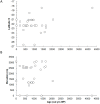The pre-Columbian introduction and dispersal of Algarrobo (Prosopis, Section Algarobia) in the Atacama Desert of northern Chile
- PMID: 28742126
- PMCID: PMC5524391
- DOI: 10.1371/journal.pone.0181759
The pre-Columbian introduction and dispersal of Algarrobo (Prosopis, Section Algarobia) in the Atacama Desert of northern Chile
Abstract
Archaeological and palaeoecological studies throughout the Americas have documented widespread landscape and environmental transformation during the pre-Columbian era. The highly dynamic Formative (or Neolithic) period in northern Chile (ca. 3700-1550 yr BP) brought about the local establishment of agriculture, introduction of new crops (maize, quinoa, manioc, beans, etc.) along with a major population increase, new emergent villages and technological innovations. Even trees such as the Algarrobos (Prosopis section Algarobia) may have been part of this transformation. Here, we provide evidence that these species were not native to the Atacama Desert of Chile (18-27°S), appearing only in the late Holocene and most likely due to human actions. We assembled a database composed of 41 taxon specific AMS radiocarbon dates from archaeobotanical and palaeoecological records (rodent middens, leaf litter deposits), as well an extensive bibliographical review comprising archaeobotanical, paleoecological, phylogenetic and taxonomic data to evaluate the chronology of introduction and dispersal of these trees. Although Algarrobos could have appeared as early as 4200 yr BP in northernmost Chile, they only became common throughout the Atacama over a thousand years later, during and after the Formative period. Cultural and natural factors likely contributed to its spread and consolidation as a major silvicultural resource.
Conflict of interest statement
Figures




References
-
- Crutzen PJ. Geology of mankind. Nature. 2002;415(6867):23 doi: 10.1038/415023a - DOI - PubMed
-
- Crutzen PJ, Stoermer EF. The Anthropocene. Global Change Newsletter. 2000;41:17–8.
-
- Steffen W, Leinfelder R, Zalasiewicz J, Waters CN, Williams M, Summerhayes C, et al. Stratigraphic and Earth System approaches to defining the Anthropocene. Earth's Future. 2016;4(8):324–45.
-
- Zalasiewicza J, Watersb CN, Williamsa M, Barnoskyc AD, Cearretad A, Crutzene P, et al. When did the Anthropocene begin? A mid-twentieth century boundary level is stratigraphically optimal. Quaternary International. 2015;383:196–203.
-
- Braje TJ, Erlandson JM, Aikens CM, Beach T, Fitzpatrick S, Gonzalez S, et al. An anthropocene without archaeology—should we care? The SAA Archaeological Record 2014;14(1):26–8.
Publication types
MeSH terms
LinkOut - more resources
Full Text Sources
Other Literature Sources

